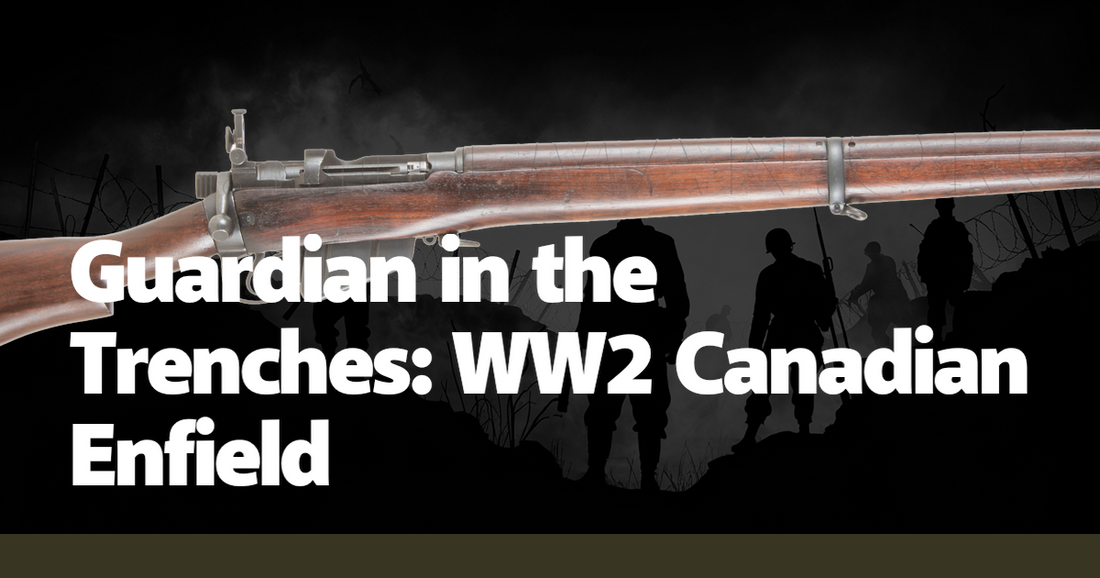The Canadian Enfield rifle, a stalwart companion to the soldiers of World War II, holds a place of reverence in the annals of military history. This weapon, officially designated as the Rifle, No. 4 Mk I*, was not merely a tool of war but a guardian in the trenches—a beacon of reliability and precision in the chaos of battle. Designed for ruggedness and accuracy, the Canadian Enfield was produced by the Long Branch Arsenal in Ontario, a facility that became synonymous with quality and craftsmanship during the war years. Each rifle that left the factory was a testament to the meticulous care and engineering prowess of Canadian arms manufacturers, ensuring that soldiers had a dependable ally in their hands.
The Long Branch Enfield was an evolution of the British Lee-Enfield series, refined to meet the specific demands of the Second World War. It featured a bolt-action mechanism, a ten-round magazine, and was chambered for the .303 British cartridge, a combination that provided a balance of firepower and reliability. Soldiers appreciated the rifle's smooth action and robust construction, attributes that were critical in the harsh and unpredictable conditions of the European theaters. The rifle's accuracy was particularly noted; it could deliver a precise shot at ranges up to 600 yards, a crucial advantage in both defensive and offensive operations. The Canadian Enfield was not just a weapon but a lifeline, a piece of equipment that soldiers could trust implicitly.
Anecdotes from the front lines highlight the rifle's importance. In the dense forests of Normandy, Canadian troops often found themselves in close-quarter skirmishes with German forces. The Enfield's quick cycling bolt and substantial magazine capacity allowed soldiers to maintain a steady rate of fire, often making the difference between life and death. One veteran recounted a harrowing encounter where his unit was ambushed during a night patrol. The Enfield's reliability under pressure enabled him to fend off the attackers until reinforcements arrived, a testament to the rifle's critical role in survival and combat effectiveness.
The rifle's design also reflected the ingenuity of Canadian engineering. The No. 4 Mk I* variant included several modifications to simplify production without compromising performance. For instance, the bolt release catch was eliminated, streamlining the manufacturing process and reducing the potential for mechanical failure. These changes were not merely cost-saving measures but thoughtful improvements that enhanced the rifle's durability and ease of use in the field. The Long Branch Arsenal's commitment to quality ensured that each rifle was rigorously tested, withstanding the rigors of mud, rain, and the relentless demands of combat.
Canadian soldiers developed a deep bond with their Enfields, often personalizing them with carvings and inscriptions. These modifications were more than mere decorations; they were expressions of identity and camaraderie. In the quiet moments between battles, soldiers would meticulously clean and maintain their rifles, knowing that their lives depended on the weapon's flawless operation. The Enfield was more than a piece of equipment; it was a symbol of resilience and solidarity, a constant companion in the uncertainty of war.
The rifle's impact extended beyond individual soldiers to the broader strategic outcomes of the war. In key battles such as the liberation of the Netherlands, the precision and reliability of the Canadian Enfield played a crucial role in the success of Canadian forces. The ability to deliver accurate fire under intense pressure helped to secure crucial objectives and ultimately contributed to the Allied victory. The Enfield's performance in these critical moments underscored its importance not just as a weapon, but as a pivotal element in the broader tapestry of the war effort.
The legacy of the Canadian Enfield endures, not only in the memories of the veterans who wielded it but also in the historical record of World War II. Museums and private collections around the world preserve these rifles as artifacts of a bygone era, symbols of the bravery and sacrifice of those who fought for freedom. The meticulous craftsmanship and robust design of the Long Branch Enfield continue to be studied and admired by historians and firearms enthusiasts alike, a testament to its enduring significance.
In conclusion, the Canadian Enfield was more than a rifle; it was a guardian in the trenches, a symbol of reliability and precision in the chaos of World War II. Its design, production, and performance reflected the highest standards of Canadian engineering and craftsmanship, providing soldiers with a dependable and effective tool in their fight against tyranny. The stories and legacy of the Canadian Enfield serve as a poignant reminder of the courage and resilience of those who carried it, ensuring that its place in history is secure.

